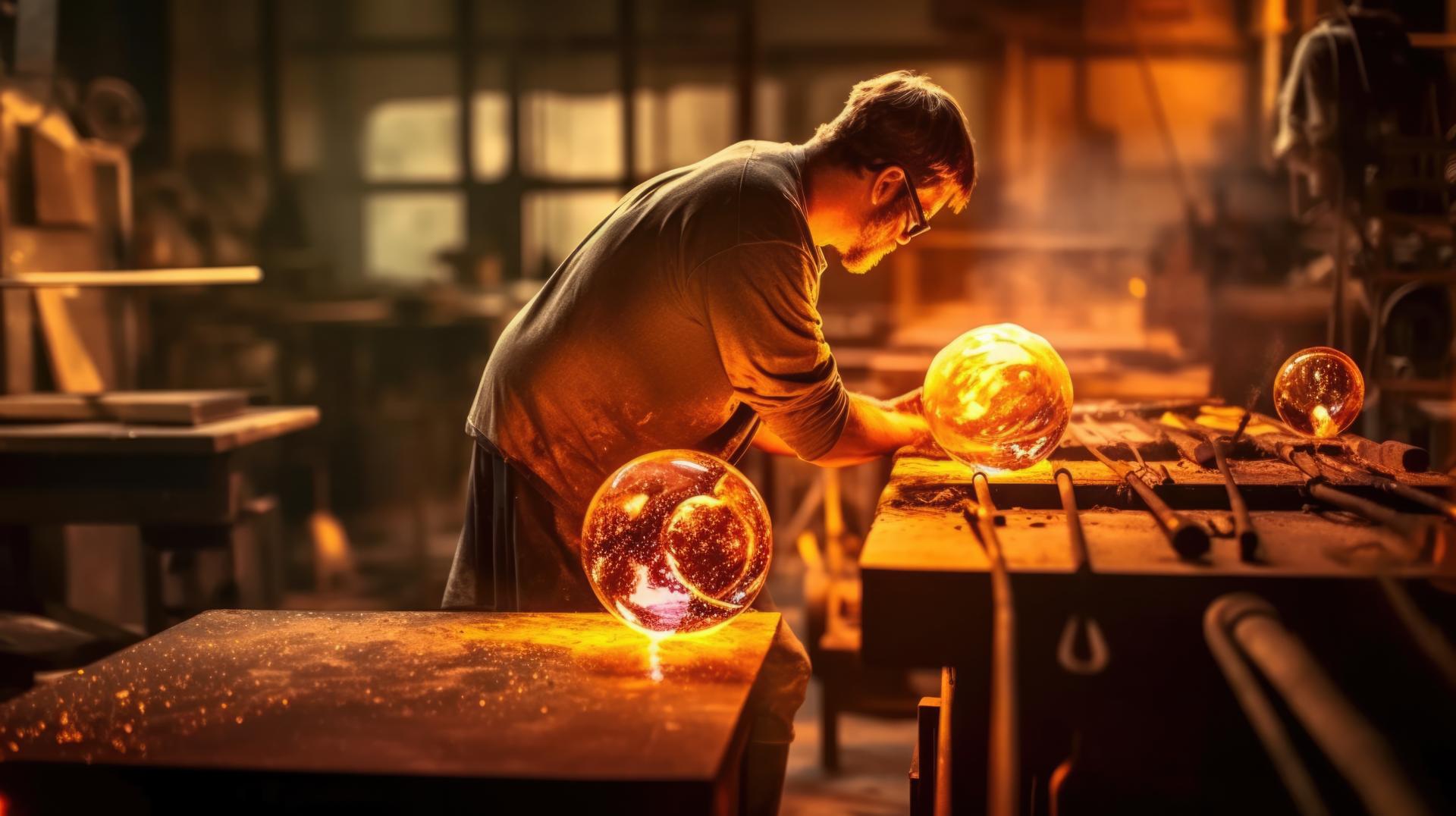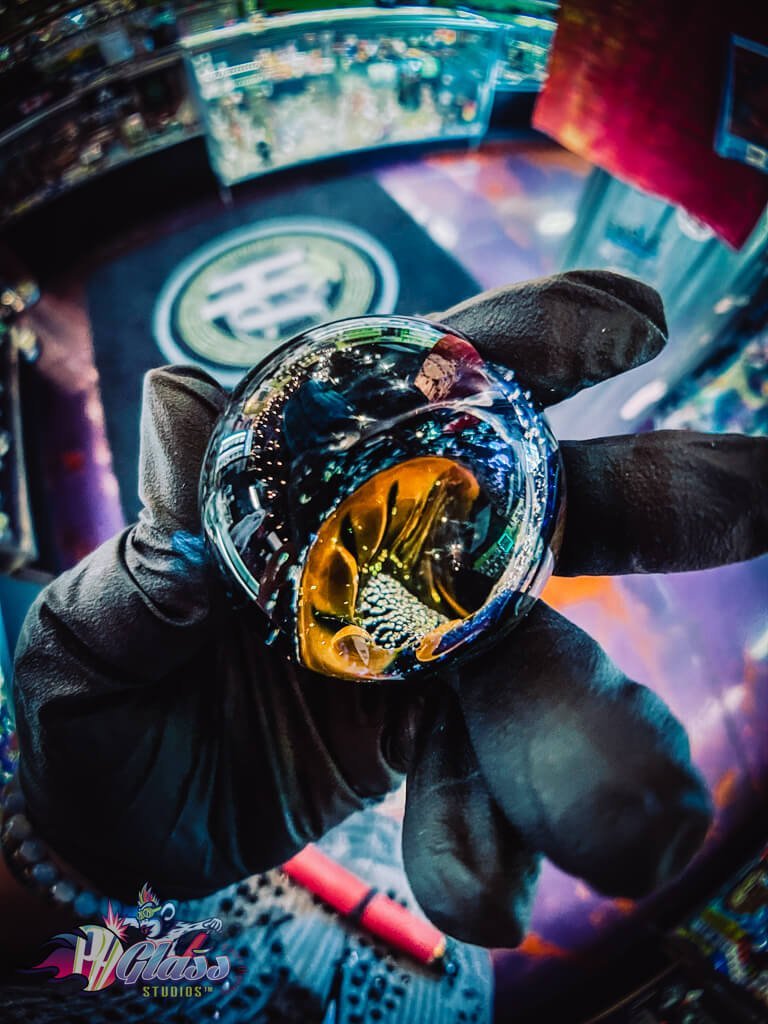You are in the right place if you have ever been fascinated by the skill of sculpting glass into beautiful items....
Menu

Glassblowing is an ancient art form that has captivated and fascinated humans for centuries. From creating delicate glass figurines to intricate glass-stained windows, the possibilities are endless with glassblowing. In this blog, we will delve into the exquisite artistry of glassblowing and explore the prowess and skills it takes to master this age-old craft.
As the name suggests, glassblowing is a process wherein artisans use specialized tools and their breath to transform molten glass into intricate shapes. The history of glass blowing is quite interesting and dates back to ancient times. According to hearsay, glassblowing is believed to have originated in the 1st century BCE in the present-day regions of Israel, Iran, Palestine, and Syria.
In due course of time, the craft boomed in the Roman Empire, and various large glass blowing workshops were established where the technique was used to create unique glass pieces for utilitarian and decorative purposes. Thereafter, the fate of glassblowing took a fascinating turn, as Italy’s trade with the Middle East led to the rise of Venetian glass-working.
You might be surprised to learn that in the 13th century, the Italian government moved Venetian glassmakers to the island of Murano to protect their expertise and prevent fires from the city of Venice’s many furnaces.
For a long time, Venetian glassworking was a well-kept secret of Venice; glassblowers were forbidden to leave. However, some experts fled Murano and took their crafts to different parts of Europe. By the mid-1600s, Venetian glassblowing techniques had reached various nooks and crannies of the world. Thereafter, the use of glass changed its purpose and reason, and the methods of cutting, engraving, and decoration also shifted through the 17th and 18th centuries.
A major milestone in glassblowing was when the 1878 Paris Exhibition of designers Eugene Rousseau and Emile Gaile led the Art Nouveau period, which lasted till the 20th century. Art Nouveau was an ‘art style’ emblematic of curves that matched well with the fluidity of glass. Almost 100 years later, in the 1950s, the Corning Museum of Glass was created by Corning Glass Works in Corning, New York. In 1951, Arthur Houghton Jr. and his cousin Amory founded the Museum as a nonprofit educational institution. Currently, the museum features collections and teaching centers with 460000 visitors stopping by annually to learn about glass.
Finally, in the 1960s, the studio glass movement was born, as American glassmakers shifted from factory settings to independent studios. Harvey K. Littleton, the Toledo Museum of Art, and scientist Dominick Labino pioneered the movement by creating smaller, cheaper furnaces for individual artists. In today’s day and age, glassblowing in Central Wyoming and all other regions of the world is considered an international art form, which continues to thrive and evolve.
After a crisp overview of the history of glassblowing, let us check out the basic premises of the process.
The process of glassblowing involves heating glass until it reaches a molten shape and then shaping it by blowing air through a blowpipe. As a glass artist, you have to maneuver the molten glass and manipulate it using various tools and techniques to create the desired shape and design. Mastering the art of glassblowing requires a steady hand, a deep understanding of the material in concern, and years of rigorous practice. If you are interested in learning glassblowing in Central Wyoming, finding a reliable workshop can help.
The basics of the glassblowing process include various techniques, such as –
One of the most crucial aspects of glassblowing is gathering. As a glass artist, you have to gather molten glass from the furnace using a blowpipe and meticulously control the amount and temperature of the glass you collect. This is the essential first strategy in glassblowing, which sets the bedrock for the ensuing pieces of the puzzle to come together. Moreover, temperature control is critical because various temperatures yield different qualities in the glasses, thereby enabling you to achieve unique and distinct effects.
Once the glass is gathered, you have to dabble into the shaping process. At this stage, it is possible to amalgamate an array of techniques to blow air into the molten glass through the blowpipe. You can use various tools like jacks or tweezers to manipulate the shape. Remember that time and precious are the two fundamental requirements at this phase, as the glass rapidly cools and hardens. An experienced glassblower is well aware of when to blow and when to shape the molten and gathered glass, ensuring that the final piece reflects their vision. You can even become an expert glassblower by opting for workshops in glassblowing in Central Wyoming.
The third phase of glassblowing includes using various techniques and materials to accentuate the aesthetics and beauty of the piece. A rather popular method is adding colored glass chips or frits to create intricate patterns and designs. These tiny fragments of colored glass, when heated and melted onto the main piece produce a mesmerizing visual effect. Professional glass blowers also use other tools to create detailed textures or infuse details to the surface of the piece.
Now that we know about the basic elements of the glassblowing process, let us dovetail deeper into the topic.
The process of making glass art via glassblowing can be quite complex. It requires a lot of skill and patience. In this section of the blog, we will check out the steps to create exquisite glass art.
Before proceeding with the glassblowing process, you have to gather the necessary materials, which include a torch, a pipe, glass rods, glass beads, and some pliers. Likewise, you would also need a workbench, a pair of safety eyeglasses, and a pair of good-quality gloves to shield your hands against the heat.
2. Prep the Glass
The second step of glassblowing in Central Wyoming is to prepare the glass for glass blowing. To do so, you have to heat the glass rod with the torch until it is soft and pliable. You may also have to rotate the glass rod to ensure that all sides are evenly heated. After the glass is heated, you have to use the pliers to shape the glass into the desired shape.
3. Create the Blown Glass
The third step in creating glass art is to produce the blown art. Insert the glass rod into the pipe and then blow it into the pipe using a consistent breathing technique, something similar to the lines of blowing a balloon. Then, the air will expand the glasses and enable you to create unique shapes and forms.
5. Mold the Blown Glass
After the glass has been blown, you have to use the pliers to mold the glass into the desired shape. You can also use beads to create patterns in the glass.
6. Cool and Harden the Glass
Last but not least, you have to let the glass cool and harden. This can be done using a wet rag and slowly cooling the glass. Once cooled, the glass is ready for display.
After a crisp overview of the five steps of creating glass art, let us skim through some extra tips and tricks that can further bolster the glassmaking mechanism.
Whether you want to build a professional career in glassblowing or want to master the fascinating art, some things can be done to achieve such milestones.
The first step is to find reliable glassblowing workshops near you. Enrolling in such classes can provide first-hand craft experience and clear your basics. Taking beginner-friendly courses can be a great way to dabble in the art and also enjoy it fully. Such workshops or glasses can help you understand if you want to establish a career as a professional glassblowing artisan. After your basics are clear, you can progress to more advanced techniques to widen your horizons and broaden your capabilities for designing and executing glassblowing plans.
We all know that practice makes a man perfect, and the same goes for glassblowing, as well. Remember to practice a variety of styles and shapes of glass art and diversify your techniques as much as possible. Such a gradual skill enhancement ensures that you can become a master of the craft and make new creations, which were previously beyond the scope of your skill level.
The third step or strategy to master the art of glassblowing in Central Wyoming is to apply to an apprenticeship or internship program. Serving as an apprentice to a more experienced glass blower helps you observe them in action and learn their techniques. You might also get a chance to assist in the glassblowing process. Thus, you get a chance to practice under professional vigilance, and under the guidance of someone who can offer timely tips and corrections as and when required to refine your technique.
Last but not least, recognize your strengths and weaknesses as a glassblower and work on improving the areas in which there is room to do so. By diversifying your skill sets and improving in the areas that you find challenging, the chances of producing high-quality and satisfying final products also increase.
Want to start glassblowing?
So, there we have it, a detailed summary of the intricate process of glassblowing. If you are interested in indulging in the art of glassblowing, then our workshops are worth considering. At Ph Glass Studio, we organize comprehensive classes and offer a Zen-like studio space where working with glass feels like a meditative and inspiring process. Our master glass blowers will provide one-on-one instructions to lay the solid foundation for further glassblowing. Besides, our studio is also open to glassblowers of all skill levels. We offer high-quality supplies, phenomenal teaching, and the best safety measures so that every step of learning glassblowing in Central Wyoming becomes a memorable experience.


You are in the right place if you have ever been fascinated by the skill of sculpting glass into beautiful items....
Glassblowing is a fascinating craft that involves making complicated and lovely objects out of molten glass. Acquiring this skill is a...
Getting the right tools is essential if you want to pursue glassblowing as a hobby. Enrolling in a glassblowing class where...
Book a couple's package for a glassblowing lesson if you plan to take your partner on a surprise date. It is...
The art of glassblowing has been around for centuries, invented by a Syrian individual around 27 BC. However, the Roman Empire,...
Glassblowing is an ancient art form that has captivated and fascinated humans for centuries. From creating delicate glass figurines to intricate...
If you want to learn glassblowing, enroll in classes or attend a workshop to teach you the art basics. As a...
Taking a glassblowing class is an incredible method for picking up fundamentals and making extraordinary pieces. Yet, what would it be...
You might be interested in learning about Glass blowing if you are captivated by the complex beauty of glass artwork. Want...
If you want a creative outlet and want to do something completely new, consider enrolling for glassblowing near Casper, WY. Sounds...